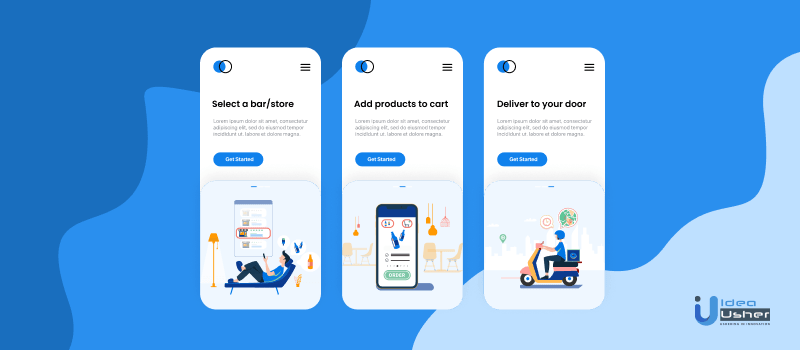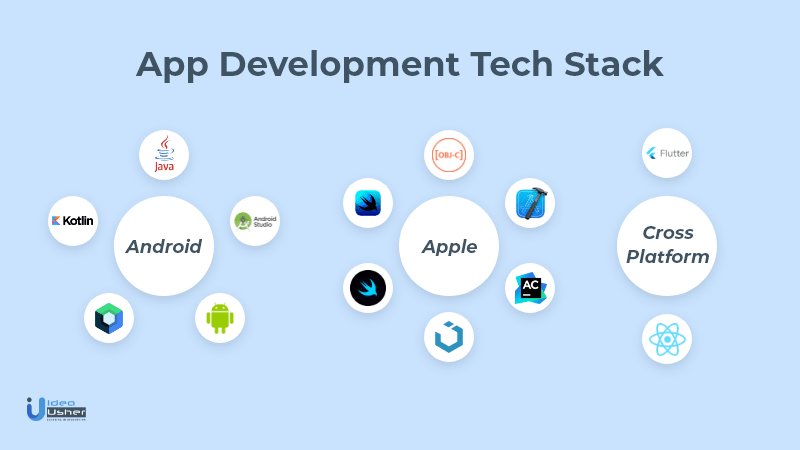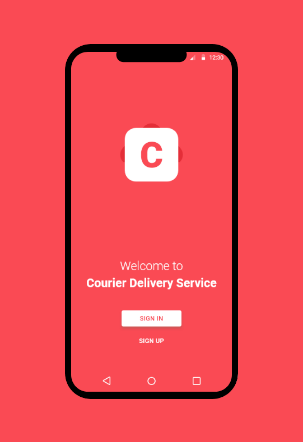Recently, COVID-19 has transformed the dynamics of the world as we know it. Whether you want to get a courier delivered to any location or wish to have your dog walked, you will find an app for it. This brings the question, why not have an app to have liquor delivered to your door. For most millennials, alcohol is an essential part of their socialization. Like any other on-demand delivery app, a liquor home delivery app can also be a viable option.
The surge in on-demand delivery apps has made sure that you do not have to bear the hassle of visiting the store. Subsequently, a booze home delivery app can ensure that you don’t need to worry about your stock getting finished in the middle of a party.
|
Liquor delivery business overview | |
| Countries where these apps are popular | USA, South Korea, UK |
| Products listed | Wine, beer, champagne, and other spirits |
| Market Size | $2.6 billion in 2019 |
| Top 5 liquor apps in the market | Drizzly, Saucy, GoPuff, Minibar, and DoorDash |
| Active monthly users | 2 Million |
| Average downloads on Play Store | 10 Million |
| Average downloads on Apple Store | Approx. 100K (monthly) |
| App ratings | 4.8/5 |
| Legal compliance requirements | In USA, you will need:
|
Alcohol Market in 2023
As of April 2023, the revenue in the alcohol market is $283.80 billion. Simultaneously, the bar and nightclubs are responsible for a whopping $36.40 billion market. The shutdown in the market caused by COVID-19 has increased the need for alternative sources that can overcome the industry’s losses.
Why Invest in Building an Alcohol Home Delivery App?
- Recently, a survey by Statista found that US consumers are spending $57.6 billion on different on-demand delivery apps. These apps include transportation, online market, food, groceries, and various other services.
- Moreover, a new report published by IWSR shows that the online sales of alcohol will increase five times by 2024, making it one of the broadest markets in the coming years.
- Furthermore, the reason behind the surge is the underlying trends that have only now been tapped into, one of these being the natural preference of millennials to drink at home. Along with this, most people agree to spend a few extra bucks to get their drinks delivered rather than going to a store to buy them.
- Thus, it is clear that the market of online alcohol is ripe with opportunities. The increasing popularity of such apps across the globe prove that it is the right time to enter the market.
Type of Business Model
Alcohol delivery apps have become increasingly popular in recent years, providing customers with a convenient and easy way to order their favorite drinks from the comfort of their own homes. However, not all alcohol delivery apps are created equal, and different business models offer distinct advantages and disadvantages.
1. Aggregator App
The first type of business model is the aggregator app. In this model, the app owner acts as an intermediary between the customer and various alcohol dealers. The app provides a platform for dealers to list and market their products, while customers can browse and place orders as needed.
The main advantage of this model is that the app owner only needs to invest in the development of the mobile app itself, and can earn revenue through in-app marketing, advertisements, and endorsements.
2. Dedicated App
The second type of business model is the dedicated app. In this model, the app is owned by a specific alcohol dealer or business establishment. This allows the owner to not only list their products, but also to manage the entire ordering process, including inventory management, delivery, and customer feedback.
This model offers more control and customization for the business owner, but also requires a higher investment in app development and maintenance.
3. Marketplace App
The third and final type of business model is the marketplace app. In this model, the app acts as an online platform for alcohol shopping between various dealers and customers.
The operator of the marketplace does not typically own any inventory, but instead provides a platform for sellers to manage their own deals, delivery, and inventory. This model can be advantageous for both customers and sellers, as it offers a wide range of products and the ability to compare prices and options.
Features of an Ideal Liquor Home Delivery App
An on-demand alcohol delivery app provides alcohol retailers with an eCommerce platform. Consumers can use the app to browse and buy an array of varieties of liquor, including whiskey, wine, beer, gin, etc.
Once the consumer chooses the desired variety and brand of the liquor, they can get it delivered to their doorstep. Afterward, the retailer can handle the delivery on their own or hire a third party service.

To clarify, it is just a brief overview of how an alcohol app works. Subsequently, based on the services offered by the best alcohol delivery app, here is a list of general features that your app must include.
Customer Panel
- Log in or sign up to ensure that they are of the legal age.
- Browse liquor products
- Filters to choose the required product categories
- Place orders to be delivered at the required location
- Track orders
- Payment methods, including online payment options and COD
- View order history
- View discounts, offers, and promo codes available
- Review products ordered
- Provide feedback
- Manage user profile
- Push notifications
Merchant Panel
- Registration of business and login
- Create, modify, update, and delete drink categories as per availability
- Manage the product prices
- Include and manage complimentary snacks provided with drinks
- View product ratings and reviews
- Manage to deliver executives
- Ability to accept or reject an order
- Manage store earnings
- Generate sales reports
Delivery Manager
- Add, delete, suspend, and manage delivery executives.
- Manage ongoing and pending orders
- Assign orders to delivery executives based on their locations
- View customer’s delivery address with GPS
- Addressing customer queries and needs through in-app chat/call
Admin Panel
- Register and login
- Liquor retailer management
- Consumer management
- Product and price management
- Order management
- Payment management
- Offers and discounts management
- Push notifications
- Real-time reporting
Additional Features to Make Your Liquor Delivery App Stand Out
Every on-demand delivery app has the list of features given above. However, the functioning of a liquor home delivery app needs to be different. After all, there is an age restriction on buying liquor. Along with that, various government policies are provided to govern the liquor retailer and their sales. Thus, some additional features need to be included in the alcohol app. These features are detailed below.
1. Social Login
First, the users must be able to sign up with their email ID and contact details. The app should provide the users with the option to sign up with an existing social media account. Moreover, the feature ensures that there is the slightest barrier between users and the app services.
2. Document upload
After this, once the customers have logged in, the app should provide them with a user-friendly process to upload their documents. These documents prove that they are eligible to purchase liquor online.
Furthermore, the app should have a similar feature for the store managers as well. They will need to scan their government-issued documents to prove that they have the permit to sell liquor online.
3. Document verification
Once the consumer and merchant have uploaded their documents, the admin panel should verify them immediately and display the results on the app.
4. Behavior tracking
Additionally, with behavior tracking, one can study the interests and preferences of the customers. Thus, the app can personalize the results as per the specific requirements of each user. Behavior tracking can also optimize the ads and offers provided by the store manager.
5. Multiple payment gateways
Also, the alcohol delivery app should offer different ways to make payment, such as debit cards, e-wallets, COD, etc. The customers must have an easy and quick experience while making payments.
6. Loyalty program
Whether operated from retail stores or bars and restaurants, the alcohol business has always been based on loyalty. Thus, offering special discounts, vouchers, etc., to loyal customers can help retain them for a long time.
Step-by-step Process to Build an Online Alcohol Delivery App
To sum up, we have addressed the essential features that the best app for alcohol delivery should have. Here are the five basic steps that need to be followed to create an alcohol delivery app like Drizzly and Saucy.

Step 1: Plan the App
The first step towards building an app is to cement a strategy. The strategy will include value ideas and principal capital, costs for developing the app and income flows. When you have a definite plan for your app, you can translate it into a more impacting proposal. You should also begin creating or finding funds so that there are no hindrances throughout the process.
Step 2: Hire a Developer
It would be best if you had technical assistance and experts that could help you bring your app idea to life. The developer will first assess your plans to ensure that they are executable and functional. Moreover, while getting in touch with a developer’s team, explain your suggestions, expectations, and motive. Ensure that you communicate clearly to avoid any miscommunication in the future.
Furthermore, you should make sure that the development team and your ideas and working ethic align. The better in sync you will be with the team, the better the application will be.

Step 3: Building an interactive and working UI
As you begin creating a database for the program, your attention should be towards the app’s user interface. It should be easily navigable by all parties, including the customers and retailers. Get designers and brand managers on board to develop an experience that is friendly and interactive.
Step 4: Work on backend development and database.
Once the UI/UX of the app is designed, you will need to work on backend and storage applications. In the beginning, start with a limited data set that can help you test the functionality of your software. As you try it, you will understand how the software functions. Based on your experience, you can recommend any improvements and changes in the software.
Step 5: Testing
Once the revisions are made to the software and the developer has completed the debugging process, then you can launch the app as a test app. Based on users’ experience, you can keep updating the app.
Monetization Opportunities for Liquor Home Delivery App
There should be a clear plan regarding the monetization opportunities that the app poses. It will regulate how the app plans to make money. Here are some of the techniques that you can adapt.
1. Commissions
You can charge a specific fee as commission for every order placed through the app. It is one of the easiest and most widely used monetization techniques as you connect the retailer with their consumers directly.
2. Ad management
By placing relevant ads on your app, your liquor home delivery app can make money. You will charge a specific fee from the advertised business as you provide them with the opportunity to reach a wider audience.
3. Featured listing
Furthermore, another popular way that your app can make money is by providing featured lists. The top spots are offered to retailers who agree to pay a specified amount of money. Consequently, as these merchants are placed on the top, they gain maximum sales.
4. Additional eStore
Similarly, you can add the feature of an e-store to your app. You can offer products related to liquor and alcohol at the store, for example wine glasses, beer glasses, etc. These items can help keep the users engaged with your app.
How Much Does It Cost to Build a Liquor Home Delivery App?
Various factors affect the final cost of an alcohol delivery app. These are detailed below.
App development team
Above all, the first requirement of any app is a development team. An experienced and expert developing team will be able to facilitate all the required features in the app. The fees of the team will depend upon the technical complexities of the features. The cost will also depend upon the UI/UX of the app.
Platform selection
Based on your choice of the platform where you want your app to be hosted, the launch cost of your app will vary.
Backend support
Likewise, you will need to invest in a reliable and skilled backend developer.
Update and Upkeep
Furthermore, it is advisable to keep a certain amount separate for constant updates and upkeep of your app. These updates are essential to ensure that your app keeps running seamlessly.
Final Words
In conclusion, the pandemic has proved that alcohol home delivery apps can be a rewarding business sector. As people become more dependent on on-demand apps, you can utilize the opportunity to begin a successful business.
With our experienced and capable development team, you can begin the process of building the best alcohol delivery app now. Get in touch with the team to explore your options and create a sustainable monetization model.
FAQs
Here are some of the most frequently asked questions about liquor home delivery apps.
Q. Can I sell liquor online?
A. With proper legal and business documents certified by your government, you can begin selling liquor online. There can be additional laws for eCommerce businesses, depending upon your residential state.
Q. How do I start an online liquor delivery business?
A. Firstly, check your eligibility based on your country’s laws. For instance, you can register for an eCommerce license once you have determined that you are eligible.
Q. How to start your delivery app?
A. You need a specific business plan with a monetization model. After that, you can create an app layout with the help of a development team.






















